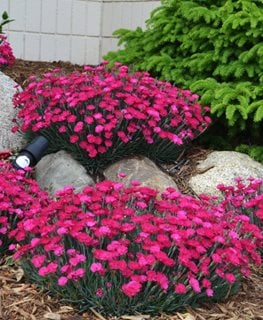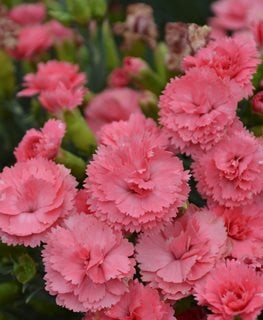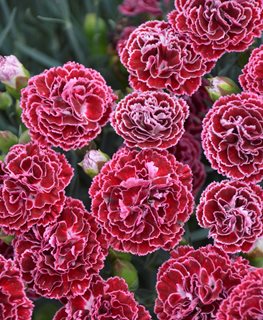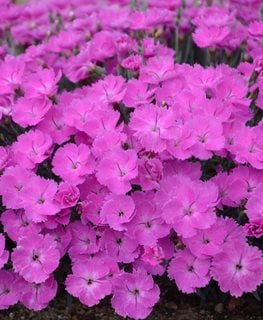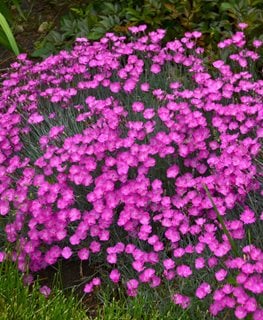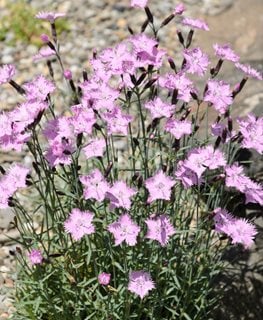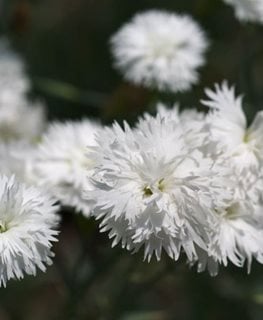HOW TO GROW & CARE FOR DIANTHUS FLOWERS IN YOUR GARDEN
Add beauty and fragrance to your garden with this old-fashioned favorite Updated: 7/1/25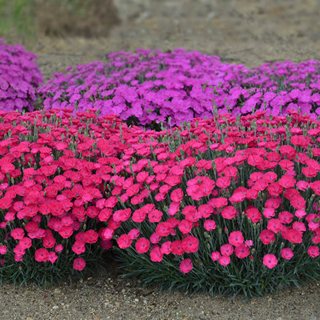
Photo: Proven Winners Perennials
A welcome sight in the garden come spring, dianthus plants are low maintenance with spicy clove-scented flowers that offer cottage-style appeal.
Here are a few more reasons to grow dianthus in your garden:
- Blooms in nearly every color, from white to almost black.
- Attracts butterflies and hummingbirds, as well as pollinating insects.
- Comes in a range of shapes and sizes, from low groundcovers to upright varieties.
- Perfect for border displays, rockeries, containers, and cutting gardens.
On this page: Basics | Types | Planting | Care | Pictures | FAQs | Landscaping Tips
On this page:
- BASICS
- TYPES OF DIANTHUS
- HOW TO PLANT DIANTHUS
- DIANTHUS CARE AND MAINTENANCE
- DIANTHUS PICTURES
- FREQUENTLY ASKED QUESTIONS
- DESIGN IDEAS
DIANTHUS BASICS
Zones:
3-9, differs by variety
Native region:
Native to Europe and Asia.
Height/Spread:
Depending on variety, dianthus can grow from 4 to 36 inches tall and 4 to 24 inches wide.
Exposure:
Bloom best with at least six hours of full sun, but can tolerate partial shade.
Bloom time:
Spring to early summer; some rebloom intermittently or continuously through summer and fall with proper care like deadheading.
Color and characteristics:
Frilly single to double blooms in nearly every color but blue; grass-like foliage in green to silver tones.
Toxicity:
While the flower petals are edible when grown organically (North Carolina State Extension), the foliage can cause minor skin irritation in some individuals, with effects usually lasting just a few minutes. The plants can be mildly toxic to pets if ingested.
Deer resistance:
Dianthus are seldom bothered by deer.
Home Garden Tip:
"Consider growing the biennial 'Electron' among your permanent perennial plantings and allow it to reseed after the initial planting. To encourage reseeding, leave some of the blooms on the plants to develop and scatter seed.”
— from The Cut Flower Handbook, by Lisa Mason Ziegler
TYPES OF DIANTHUS
Dianthus comes in many forms—annuals, perennials, and biennials. Here are the most popular types gardeners should know.
- Pinks (Dianthus plumarius): Evergreen or semi-evergree perennial, fringed petals, grassy foliage. The name comes from looking like they were cut with pinking shears.
- Cottage pinks (D. plumarius subset): Compact, fragrant, and ideal for traditional cottage gardens
- Sweet William (D. barbatus): Biennial/short-lived perennial, upright habit, colorful dense flower heads.
- Carnations (D. caryophyllus): Perennial or annual, long-stemmed favorites used in floral arrangements.
- Cheddar pinks (D. gratianopolitanus): Perennial, mat-forming habit, drought tolerant.
- China pinks (D. chinensis): Annual/short-lived perennial, bushy, colorful; common in bedding.
- Alpine types (D. alpinus and various spp.): Compact, low-growing; thrives in rock gardens and gravel beds
HOW TO PLANT DIANTHUS
When to plant:
Planting times depend on the type you're planting.
- Perennial types: Plant during cooler months in early spring or fall.
- Biennials and annuals: Plant nursery starts outside in spring, or sow seed indoors 6 to 8 weeks before your last frost date for bloom the same year.
- Seeds sown directly in the garden in late spring or summer will bloom the following year.
Where to plant:
Choose a site with rich, well-draining soil in full to part sun. Plants will bloom best in full sun; too much shade can result in fewer flowers and crown rot.
How to plant:
Here's a basic planting overview.
- Place plants 6 to 12 inches apart, depending on the variety.
- Loosen soil to a depth of 12 inches and mix in 2 to 4 inches of compost.
- Dig a hole twice the diameter of the root ball and place the plant in the hole so the top of the root ball is level with the soil.
- Gently tamp soil around the base of the plant and water well.
DIANTHUS CARE
Deadheading:
Deadhead (cut off spent blooms). Removing spent flowers encourages new flowers.
See more on deadheading and shearing back dianthus at 1:10.
Dividing:
Divide older clumps if growth thins in the center. Cut clumps into several pieces, removing the dead foliage, and transplant divisions to new spots. (Learn more on how & when to divide perennials.)
Soil:
Carnations, sweet William, and cottage pinks do best in rich, well-draining soil that’s kept moist but not soggy. Alpine types, such as cheddar pinks, prefer a slightly alkaline, sandy soil with sharp drainage.
Amendments & fertilizer:
Here are several guidelines for making sure your dianthus get the nutrients they need.
- For established perennials, apply a thin layer of compost in spring and sidedress with a well-balanced fertilizer according to instructions.
- Avoid organic mulch, as it can contribute to rot or fungal problems; instead, use gravel or stone chips to suppress weeds.
- For biennials or annuals, apply a liquid fertilizer monthly during bloom time.
Watering:
Water once a week in summer, or more frequently in hot weather if needed. Avoid overwatering, which can cause rot. Overhead watering may cause leaf mildew.
Staking:
Carnation types with long stems may need staking to keep them from falling over.
Diseases and pests:
In addition to being easy to care for, dianthus are free of most pests and diseases when healthy and planted in the ideal site. Just like any plant, though, there are potential problems that can occur.
- Overwatering or heavy mulch can cause crown rot.
- Poor drainage can result in stem rot or root rot.
- Insect problems can include slugs and snails, sow bugs, spider mites, or grasshoppers.
DIANTHUS VARIETIES
FREQUENTLY ASKED QUESTIONS
Are dianthus flowers annual or perennial?
Dianthus can be annual, biennial, or perennial depending on the species. Pinks and some hybrids are perennials, Sweet William is often biennial, and carnations can be annual or perennial depending on your climate.
When do dianthus bloom?
Most dianthus bloom from late spring to early summer, and with regular deadheading, many can bloom again later in the season.
How much sun do dianthus need?
Dianthus thrive in full sun, needing at least 6 hours of direct sunlight daily. They can tolerate partial shade but will produce fewer blooms.
How do I care for dianthus to keep them blooming?
Regular deadheading, well-drained soil, moderate watering, and light fertilization during bloom time will keep dianthus healthy and flowering longer.
Are dianthus toxic to pets?
Yes, dianthus can be mildly toxic to cats and dogs if ingested and may cause skin irritation. Keep pets away and consult a vet if ingestion occurs.
DIANTHUS LANDSCAPING TIPS
With so many choices, here are some tips to consider.
For bedding displays and borders:
Edge the front of a border with low-growing perennial varieties. Sprinkle annual or biennial seeds to fill in gaps between established perennials.
For containers, rock gardens, and small yards:
Dwarf and mat-forming types will stay smaller and not overwhelm a space. Combine in containers, rockeries, or beds with other small annuals or perennials that thrive in the same growing conditions.
For cutting gardens and large-scale landscapes:
Choose Sweet William or carnation varieties that will grow tall and plant them in rows or masses for the greatest visual impact. The stately stems and long bloom time make these suitable for floral arrangements.
There are many ways to incorporate this beloved heirloom into any landscape. Here’s how:
- Mass in a bed along a patio or deck, where the spicy fragrance can be enjoyed up close.
- Plant alpine types in a rock garden or crevice garden with other plants such as columbine, sedums, thyme, creeping phlox, and lamb’s ear. See more in this video, Creating Your Crevice Garden, from Walters Gardens/Proven Winners Perennials.
- Dress up an entryway or balcony with a decorative container and plant with dianthus in varying colors, or with annuals such as sweet alyssum, lobelia, and dusty miller for months of continuous color.
- Place window boxes on a side of your house that receives full sun and plant dianthus in cheerful colors for a nostalgic, cottage-style effect.
- Line a pathway with shorter varieties that bloom at different times for a season-long display of color.
- Convert a raised bed into a cutting garden and plant carnation types with long stems. Add other cutting flowers such as dahlias, sweet peas, zinnias, and sunflowers for freshly cut bouquets through summer and fall.
- Combine in a mixed border with other cottage-style plants such as cranesbill geranium, coral bells, iris, roses, columbine, artemisia, and lavender.
ABOUT THE AUTHOR
Janet Loughrey is a veteran garden writer and photographer with over 25 years of experience, contributing to major publications like Garden Design, Better Homes and Gardens, and Sunset. A former Master Gardener, she brings hands-on expertise from gardening in a wide range of climates, from upstate New York to the Pacific Northwest.
RELATED:
Ideas for an Enticing Cottage Garden
21 Easiest Flowers for Beginners
16 Surprisingly Drought-Tolerant Plants
20+ Cottage Garden Plants & Flowers
